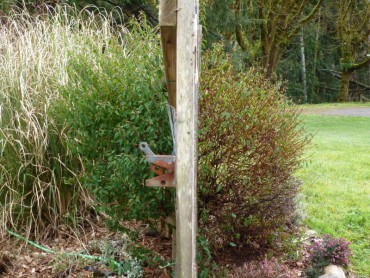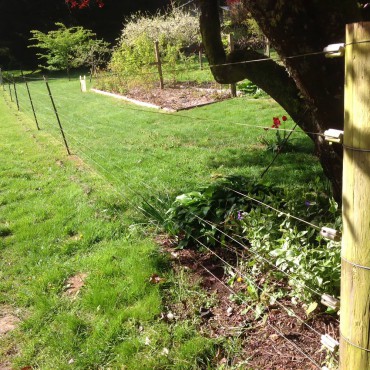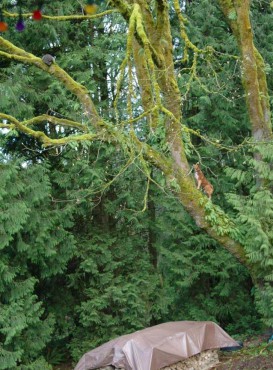
I expect you’ve heard that the only way to protect your plants from hungry deer is a good fence.
The deer in my neighborhood illustrate this point perfectly.
Before I built my current fence, I kept my treasured deer “candy” covered in black netting. Harvesting strawberries from under the fencing was tedious, and as plants grew through the netting, it became difficult to keep them free of it.
It was a pleasure to release my plants from bondage as soon as I came up with a deer fence design I could live with.
For various reasons, not everyone wants a fence, and many of my clients’ gardens are visited by deer. We employ multiple strategies to minimize browsing damage.
The first line of defense is plant selection. I have considered quite a few plants safe bets, but every year the new crop of deer surprises me with their willingness to try something new.

Sword fern, prickly Oregon grape cultivars, spiraea and perennial geraniums have been safe bets in the past, but no longer!
When plants are newly planted, I like to spray them with Tree Guard or Liquid Fence right after planting, as deer like to sample new plants to see if they are palatable.
Plantskydd is another product many swear by. The spray teaches the deer to avoid the new plantings and should be reapplied according to directions, as new growth appears.
After the first month, you should be able to keep an eye out and spray only the plants that need it.
All of these repellents are resistant to rain. Be sure to stand upwind of your plant while spraying, and apply during calm conditions.
Alternating repellents helps with effectiveness.
One of my clients has had satisfactory results using Sweeneys Deer Repellent tucked among her favorite deer candy treasures. Disks filled with blood powder release some of the product as they move, and spook the deer away.

Fencing for Deer Protection
You have to decide how much damage you are willing to accept. Often, the deer come through only occasionally and browse lightly. You can thank them for the light pruning and enjoy their company for a while, and perhaps send Spot outside to get them to move on to the neighbors’.
If the pressure is high, however, and you want to grow plants you know will attract herds of gourmand deer, it may be time for a fence. Perhaps you can create a small fenced area for your vegetables and fruits, your roses, tulips and Heucheras.
If the area is fairly small, the deer may not jump into it even if the fence is not very high (4-5 feet), since they do not like confined spaces.
I settled on a style of fence that looks like a traditional 4-foot cedar picket fence with inconspicuous wires installed every 12 inches to a height of 8 feet.

You can also use a low, 4-foot electric fence. Even though the deer could easily jump a fence that high, if you condition them to fear it by baiting it with a little peanut butter in the spring time, they will avoid it even when it is not on all the time.
You do need to train them, however, or they will figure out that they can easily jump over it without making contact.
Even though deer no longer trim my flora for me, I still share my crops generously with a growing family of raccoons, who get most of the plums, strawberries, grapes and figs; the birds, who polish off the cherries and blueberries; and, of course, the slugs and snails that in a good year get all of our pea seedlings and dahlias.
Oh yes, the voles have had a few good years as well — severing perennials at ground level, or eating all of the roots just below ground level.
I do not mind sharing, mind you, but these critters do not seem to care about sharing fairly!
I will be looking into temporary electric fencing to place around the trees that are ripening their fruit this year, in hopes of keeping the harvest for us as well as preventing the chubby raccoons from breaking many branches.




























Comments